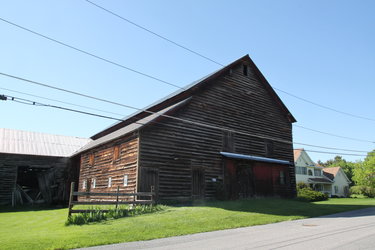New location posited for site of historic battle
GUILDERLAND — The only Revolutionary War battle fought in Albany County, the Battle of the Normanskill, long noted with a state historical marker along Route 146, may not have been fought there after all.
Aaron Mair, a Guilderland resident who is African American, continues to be passionate about raising a monument to honor the mixed-race regiment that fought in the battle regardless of the location.
On Aug. 11, 1777, an army of British loyalists, American Tories, had assembled on the banks of the Normans Kill, as the late town historian Arthur Gregg told it, so the Schenectady Regiment and a company of Continental Regulars from Rhode Island were sent to meet the Tory army.
Many of the Tories fled while a dozen or so Tory leaders hid in the hay mow of a nearby barn but were forced out when Patriot soldiers jabbed the hay with their bayonets, Gregg said. Their leader, David Springer, was shot and killed and the others were sent to an Albany prison.
Jeff Perlee, an Albany County legislator who chairs the county commission overseeing the celebration of the nation’s 250th anniversary in 2026, has done research that shows the battle was fought in what is now a suburban housing development on Vosburgh Road — with a 1700s barn still standing.
Perlee said the current bridge construction project on Route 146 got him interested in where and how the original trail used first by Mohicans then by Palentines, becoming the Schoharie Road, crossed the Normans Kill.
An archived 1975 article from The Altamont Enterprise led Perlee to maps from 1778 prepared for George Washington by Robert Erskine, the Continental Army’s cartographer, which are now in the collection of the New York Historical Society.
Erskine’s maps identify the owners of two homesteads — Van Patten’s and Bancker’s — near the Normans Kill that match the 1767 Bleeker map, Perlee said.
Gregg transposed the two properties, Perlee says, concluding erroneously that “Van Patten’s house was closest to the creek, when in fact it was the one that sat further away, up the hill at the end of today’s Vosburgh Road. The house and barn (where the Tories reportedly hid under hay) that Gregg erroneously identified as the battle site actually belonged to Patriot John Bancker!”
Perlee did title searches to confirm the 1767 and 1778 maps are correct.
“Here’s where it gets exciting,” Perlee reports. “The Bancker house and barn is long gone. I poked around there as a kid before they fell down in the late ’80s. As such we all believed that nothing was left of the battle site.”
However, the barn on the correct Van Patten farm site is still standing and is still owned by a Van Patten. “Happily, the barn is nearly surrounded by town park land,” said Perlee.
Perlee visited the barn earlier this month with Don Rittner, who chairs Guilderland’s 250th anniversary committee and is an expert in 18th-Century Dutch barns, and confirmed that’s what it is, Perlee said.
The monument
Mair told The Enterprise on Tuesday that he has been working with the sculptor, Thomas Jay Warren, who created a bronze monument for Yorktown depicting Colonel Christopher Greene of the 1st Rhode Island Regiment along with a Black soldier and a Wampanoag soldier, of which there were a dozen in the regiment.
Mair helped with raising funds for that $300,000 statue.
“The current administration is removing African Americans from American history,” said Mair. “There is a refusal to tell American history at all.”
Mair has been out of town for a fortnight and said, on his return, he will catch up with the specifics of Perlee’s research.
But he said, as the town, county, and state gear up to celebrate the 250th anniversary of the nation’s founding, “This is a powerful, teachable moment to lift up the ideals of the Declaration of Independence.”
He went on to recite from the Declaration, emphasizing the word “all”: We hold these truths to be self-evident, that all men are created equal, that they are endowed by their Creator with certain unalienable Rights, that among these are Life, Liberty and the pursuit of Happiness.
Mair said he would like to work with schools across Albany County to teach them about how, in leading the 1st Rhode Island Regiment, Colonel Greene said, “I want those who will fight.” This included Black Freemen, Native Americans, and European settlers.
“To me,” said Mair, “having a place to lift up that narrative pulls us together … despite the national trend of polarization.”
The banner carried by the 1st Rhode Island Regiment was emblazoned with the motto “hope,” he said. “We need hope now more than ever,” said Mair.
The battle
Although the Battle of the Normanskill is often called the lost battle of the Revolution, A. C. Flick, New York State historian in the early part of the 20th Century wrote, “This brief encounter might be passed over lightly by one not familiar with conditions in Albany at the time, but it brought about results of the greatest importance.”
Flick writes of how the British general, John Burgoyne, was advancing down from Canada towards Albany. “Many families had fled and terror was in the heart of every patriot, for did the British gain the old Dutch city, independence was lost. The patriots were hemmed in on every side ….
“Burgoyne was successful in sending Tory aids to all parts of the colony of New York, where they stirred up the royalists and brought wavering patriots to the British side. Exaggerated reports of the success and rapid approach of the three expeditions of the British were spread and all too unhappily believed.”
After news that the “concentration of the Tory band on the Normanskill” had been dispersed “and that the principal Tories were imprisoned, there was great rejoicing,” Flick wrote. The victory on the Normanskill, he said, was followed by the successful defense of Fort Stanwix, the halting of the British at Kingston, and then the victory at Saratoga.
“The lost battle of the Revolution,” Flick concludes, “became the turning point in rallying the spirits of the patriots.”



